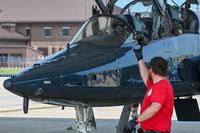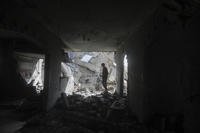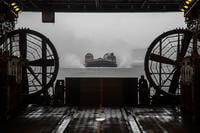The U.S. Navy plans to base 60-percent of its fleet near or in the Pacific theater regardless of what happens with sequestration and ongoing budget uncertainties, service Secretary Ray Mabus told reporters last week.
“We are absolutely committed to the rebalance to the Pacific. We’re sending assets there regardless of what happens with the budget.We will have 60-percent of our fleet in Asia regardless of what happens elsewhere,” Mabus said.
In particular, Mabus said four of the services’ now-in-development Littoral Combat Ships will be slated for rotational deployments in Singapore and that additional Marine Corps units will be rotating through Australia.
In fact, over the next several years, the number of Marines rotating through Darwin, Australia, will go up to as many as 2,500 – forming a Marine Corps Air Ground Task Force, Corps officials indicated.
Mabus emphasized the importance of sustaining an impactful global presence and training with key allies – all as part of the Pentagon’s national defense strategy which, among other things, calls for a Pacific pivot and an agile, deployable, technologically superior force.
“This is what the Navy and Marine Corps do, with a small footprint or no footprint. We train and have exercises all over the globe. The fact that this is now a formal part of our defense strategy, raises its importance,” Mabus said. “We are committed to the Pacific focus, the Arabian Gulf and building partnerships to make sure that together, we can meet challenges.”
While by no means restricted to the Pacific theater, the much talked about AirSea Battle operating concept has great relevance to the kinds of challenges posed by the Pacific region.
Based upon the need to overcome the challenges posed by what Pentagon officials call Anti-Access/Area-Denial, or A2/AD, AirSea Battle is an operating concept designed to help the U.S. military project and sustain power in a more challenging and complicated future global technological environment, its advocates say.
Mabus mentioned A2/AD when asked about AirSea Battle and whether it is properly housed or configured as primarily an Air Force-Navy collaborative effort or should instead be run by Pentagon’s Office of the Joint Chiefs of Staff; Mabus indicated that the AirSea Battle concept is entirely “joint” in nature and intended for all services, but added there were some areas of the operating concept which benefitted from particular or more specific Air Force and Navy coordination.
A2/AD is current Pentagon-speak for how the U.S. military must be prepared to face potential adversaries which are much more technologically advanced than those faced in Iraq and Afghanistan. As more potential adversaries are now equipped with longer range ballistic missiles, some with various kinds of precision guidance capabilities, it becomes more challenging for the U.S. to operate freely and project power in an uncontested fashion, AirSea Battle advocates maintain.
Essentially, AirSea Battle is based upon the premise that the U.S. military no longer has the global technological superiority or overmatch capability compared to potential adversaries it may have had merely a decade ago. The rapid development and proliferation of technologies has engendered a global environment wherein more sensors, jamming equipment, unmanned aircraft and precision-guided munitions are being developed and produced by more countries.
In particular, potential adversaries may have longer-range anti-ship ballistic missiles, making it more difficult for vessels to operate closer to shore. Therefore, while proponents of AirSea Battle are quick to point out that the operating concept is not intended to pick a certain adversary persay, they are clear that maritime security and ensuring access to key ports and waterways in places like the Pacific theater, or Arabian Gulf, is of great consequence.
The vast distances known to characterize the Pacific region speak unequivocally to the need for long-range strike, communications and ISR capabilities, proponents of AirSea Battle profess. In fact, the Navy is currently developing several maritime ISR systems designed, in part, for these kinds of scenarios, service officials explained.
“We’re fielding new capability to focus on the challenges there; it is a maritime environment characterized by vast distances,” a Navy official said.
The official was referring to the Triton UAS, a maritime version of the Air Force’s Global Hawk surveillance plane being developed by the Navy as well as the service’s plans to deploy P-8A Poseidon surveillance planes to the region.
Congressman Forbes – AirSea Battle, Sequestration
The Pentagon’s Pacific pivot was also a focal point of recent comments from Congressman Randy Forbes, ®-Va., Chairman of the House Armed Service Seapower and Projection Forces Subcommittee and vocal advocate of the AirSea Battle operating concept.
Considering these issues, Forbes recently told Military.com in an interview that he is keen on wanting to ensure that strategic questions and potential future threat scenarios drive budget decisions. Conversely, he does not want budget constraints and issues such as sequestration to disproportionately guide decisions of significant strategic import such as military readiness.
“Where are we going to be ten years from now? What is our effective reach? If they back our carriers off, how much combat space do we have?” he asked in a recent interview with Military.com.
In the context of a broader discussion about force posture, AirSea Battle and force structure and strategy, Forbes brought up the now-in-development Unmanned Carrier Launched Surveillance and Strike System (UCLASS) as evidence of the kind of next-generation technology needed by the U.S. military to address potential future threats.
A carrier based drone able to conduct what’s called long-dwell ISR (intelligence, reconnaissance and surveillance) missions over vast, geographically dispersed areas – is precisely the kind of “reach” or force projection envisioned or called for by proponents of AirSea Battle.
“The goal is to have this operate off a carrier and compliment an existing air wing. When you have these complimentary aircraft, you can go longer distances for longer periods of time,” a Navy official said.
The Navy is currently developing a similar “demonstrator” aircraft, called the X-47B Unmanned Combat Air System; the X-47B, a demonstrator aircraft intended to inform the larger UCLASS program of record, successfully launched from an aircraft carrier this past May, marking a historic, first-of-its-kind carrier launch for a large unmanned system.
A Preliminary Design Review Request for Proposal (RFP) for the UCLASS was released to the four main vendors June 10, providing them with an opportunity to submit some of the technical and design details planned for their respective proposals; the RFP release was first reported by the U.S. Naval Institute.
The four industry teams are Northrop Grumman, Lockheed Martin, General Atomics and Boeing, Navy officials indicated.
“Industry will submit data and the government will assess the technical maturity of the designs. The Preliminary Design Reviews allow the government to be better informed of technical risk, cost and design maturity,” said Navy spokeswoman Jamie Cosgrove.
The PDRs also allow the industry teams to better understand the program’s requirements, Cosgrove added. A Technology Development RFP is slated for release in August of this year, she said.
Forbes wants to amend the calculus regarding discussions of sequestration such that lawmakers, thinkers, decision makers and strategic planners frame their questions not so much in terms of what risks can be “afforded” or absorbed in a constrained fiscal environment -- but rather what is the near and long-term risk of NOT fully and properly equipping the U.S. military.
“Nobody is asking -- What is the risk if we don’t supply the necessary resources?” Forbes said.
Forbes is also outspoken regarding the current and potential future impacts of sequestration; he has consistently opposed sequestration and is a supporter of several proposed legislative options to stop sequestration. In particular, Forbes sponsored legislative proposals to end the defense portions or impact from sequestration; he told Military.com he is very concerned about sequestration’s potential impact upon force posture and force projection.
“Sequestration’s negative impact on our military readiness is significant and grows steadily more damaging with each passing day. The United States faces real national security challenges around the world and, because of Washington budget politics, we are seeing our ability to respond to these challenges significantly degraded. I refuse to accept that these arbitrary and damaging cuts are the best our Government can do to secure the national defense of the United States,” Forbes said.








